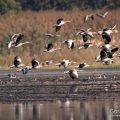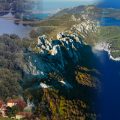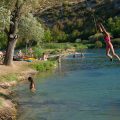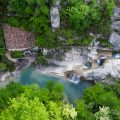Croatia’s wealth and diversity make it one of the world’s most beautiful countries. Its sunny Adriatic coast is known throughout the world, but there are other places as well, even though not many people think of Croatia as a mountainous country, mountains make up a third of its territory, Croatia’s mountains are a refuge of intact nature. Bijele stijene are a group of impressive, glistening white rock, towers that stick from the dense and wild forest of Gorski kotar. It is one of the wildest places in Croatia, where you can’t see any human structure from the rocks.
General info
Table of Contents
Bijele stijene are limestone peaks on the eastern side of Gorski kotar. They are not very high, around 1300 meters above the sea, but their wild landscape makes them so special.
The journey to Bijele Stijene starts on the one side of the town of Ogulin and goes to Jasenak. The latter is an idyllic village with typical pastures and wooden houses. As it is the rural community closest to the reserve and lies along a good road, it is usually the starting point for the mountaineers who visit the reserve. The alternative, from the other side, is Delnice via Mrkopalj and then Begovo Razdolje. From here, the journey continues along a longer forest path dating back to Turkish rule. The entrance to the reserve is reachable by vehicle in both directions, except in winter when snow blocks the area. Near the mountains is Bjelolasica, the Croatian Olympic Centre.
See our Guide to hiking in Croatia
You can stay in the mountain hut. It is constantly open in the summertime and on weekends in other seasons. It offers overnight accumulation for about fifteen people and a well-equipped kitchen. Next to it is a cistern with drinking water. Less than fifty metres away, a shelter with 30 beds and a wooden stove has been built. Although it is less comfortable than the hut, it is always open and has served many hikers during the winter months.

Read more:
As we began our difficult ascent into the woods, heavy snow began to fall. A steep slope, deep December snow and giant snowflakes sticking to our faces didn’t help our progress. Moreover, at one point, we found ourselves in the middle of a real blizzard, and the air turned into a whirling of snow that prevented us from making a single move. Despite ibis, there was complete silence throughout the forest, a soft silence, without betraying a sound of life. Only the whiteness of the snow could be seen in this lifeless landscape, as well as the sleeping black beech trees, whose tops were shrouded in snow.
The place exuded a strange, almost magical atmosphere, and man seemed out of place. The forest is part of the Bijele Stijene (White Pocks) nature reserve and starts at the end of a winding road, where the mountain rises steeply from the flatter wastelands of Hapela. This mountainous region of Croatia, called Gorski Kotar, is located at the bottleneck between the continental lowland bell and the Northern Adriatic.

Late discovery
Now, as we climb in silence, it is easy to experience the solitude that dominated the region for a long time until it was revealed to the outside world by ranger Jakob Mihelčić. He showed the way to the well-known botanist Dragutinl Hirc, whose travelogues and scientific finds attracted the general public’s attention. The depth of the snow close to the peak has increased significantly, reaching up to three metres in the drifts. Dazzling whiteness becomes the prevailing element, completely masking the beech trees, now much shorter, with widely spread low and gnarled tops. However, the snow ceases to fall, replaced by a thick fog seeping into the forest, distorting all the images. Somehow, the eerie feeling disappears and is replaced by an enchanting winter idyll. We finally climb to the peak, discovering nothing can now be seen from this huge rock. Clouds rush around, covering everything, just every now and then revealing the closest of the frozen trees.
We, therefore, returned to a small plateau below the peak where there were two lovely little huts. They seemed to have grown into the snow, hidden behind the white arms of the trees and fused into the rocks with their tall and narrow roofs. They were barely visible in the all-encompassing whiteness, and according to more experienced mountaineers’ stories, they had been buried under snow more than once and could not be found. The first mountain hut was built in this kart valley back in 1929. It was named after an explorer. For a long time, it was very popular among mountaineers, but over time, it became dilapidated, and so the Kapela mountaineering society from Zagreb built a new one, it fits nicely into the landscape on the rim of this karst valley, mounted on tail pillars to protect it from the damp. These conditions attract many hikers at almost any time of the year. They have good paths at their disposal that run along Bijele Stijene and lead to many of its attractions.
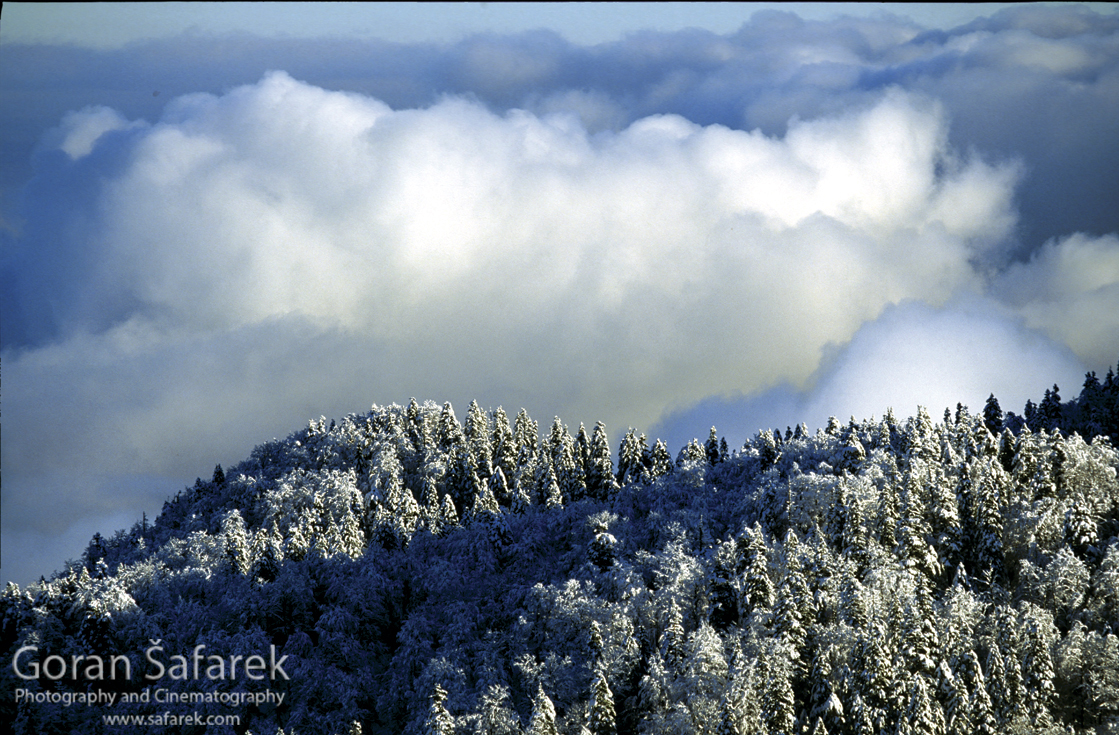
The mountain magic
The splendour of the following morning, entering through the window of the small mountain shelter, was an irresistible invitation to go outside. There, beech trees covered in snow jutted out into the endless azure of the sky. Our breath froze as the clear night drained all the heat from the air. This scene made the peak, still hidden by rocks and trees, even more alluring. The path to it runs through small fir and beech woods, which the sun had not yet reached.
This shaded place bore witness to the harshness of the wind and cold In the form of thick layers of frost of extraordinary shapes. It is quieter in the abyss, where old but still first solid use from the depths. Their tops are trimmed according to the direction of the wind, and beneath them is a cemetery of old trees with their dry and dead stumps peeping through the snow. Crossing to the other side brings an utterly different atmosphere. We carve out through a narrow passage into a vast space basking in light that offered pleasant warmth despite several little grey clouds in the sky. The image was a primaeval one, with intact, virgin snow, without any sign of human existence, the soft lines of the treetops and tips of the branches cloaked in white.
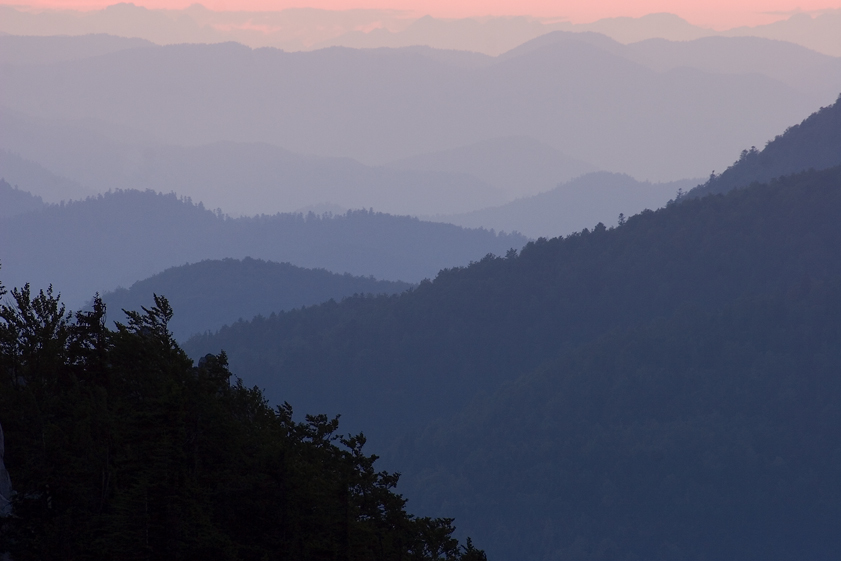
On the top
Once more, we were at the top, but this time, the view from 1335 metres above the sea was magnificent from any side. As you go inland, the hills gradually become smaller, disappearing into the thick sea of tog and row, rolling clouds. We know that the towns in the plain are suffocated in greyness, while here, on the mountaintop, everything shines in vivid and rich colours. The sea is less than ten kilometres away from the peak, and it’s hard to grasp from this position how close it really is. To the south, there is the mountainous plateau of Lika, with the mighty Velebit range rising behind it, and finally, to the north and west, Gorski Kotar.
However, besides these remote areas and panoramic views, Stijene attracts the most attention. Several stone pillars up to 50 metres tall, rising from the mountain’s crest, present a dominating view as they gleam in the forested landscape. This mountain spur is almost four kilometres long, around 2 km2 of the total surface area. The direction of its orographic axis equals that of the Dinaric Alps, but its composites are divided by tectonic rifts and ruptured by karst processes into individual groups.

Solemn wilderness
The distinctive whiteness of the rocks and the deforestation are core sequences of the long-term erosion that has turned the ridge into a natural phenomenon. The ruthless power of water, ice and cold has finely carved the rocks, sharpening their edges, grooving them and moulding them into different shapes. Although they are covered by a thick coat of snow, which softens their contours and makes them monochrome, even now, in winter, they stand apart from the slender fir trees due to their frightening size. This erosion quality is a feature of the karst landscape and the root of its beauty. A lot of the credit for this natural phenomenon, lacking elsewhere in both this quality and quantity, is due to the rockiness of a large part of Croatia.
Instead of standard mountain scenes with exquisite shapes, micro-relief is highly developed here. This is apparent when we look at the neighbouring peaks below the forest, which are plain and ordinary and no match for these rocks. Only Bijele Stijene and the neighbouring Samarske Stijene can captivate the human imagination and stir an adventurous spirit. This area is full of narrow passages, hidden caves and small meadows, or gardens made up of groves and grass. In the shadow of deep karst sinkholes, the snow stays long into the spring, and the edges of abysses hide hundreds of secret spots which one can crawl through and explore but also get lost in.

The diverse shapes compel one to recognise objects from everyday life; the consequence is that the names given to some are not so surprising. Here, you can find stone fingers, chapels, domes, tubs, chests and many other things. This is all in the karst kingdom, dominated by true virgin forest. It is almost beyond belief that plants can grow in the bare rock, particularly the tall spruce trees. Crna Draga – a valley between Bijele Stijene and Samarske Stijene only two kilometres apart as the crow flies, but in reality, much more distant due to the rugged terrain, is particularly impenetrable.
Protected as a strict reserve
The belt of forest vegetation stretches from the foot of the massif to the rocks on its crest (fir, spruce, beech, and maple), while a pine and juniper tree belt grows in the rocks. The flora is characterised by its many alpine species. The fauna includes bears and other large and small mammals, such as foxes, weasels, skunks, dormice, martens and badgers. This combined with the well-preserved environment, prompted the Croatian Mountaineering Association to request legal protection for the rocks. This action was successful, and the peaks of Bijele Stijene and Samarske Stijene were declared nature reserves by the Croatian Parliament.

The combination of wilderness and beauty attracts many mountaineers, mainly fed on standard mountain landscapes. This increasingly means foreign visitors as adventure holidays and ecotourism trends rise worldwide. The proximity of the sea is an additional advantage, which makes it easier for tourists to make one-day excursions in the summer. But winters here are magnificent 100, as we’ve now discovered. It sounds strange that tens of thousands of Croatian citizens go to expensive ski resorts in France, Austria or Italy without realising that their country offers winter beauties of its own.
The sun began setting towards the sea, and the landscape changed. It first turned yellow, and fir trees cloaked in white started to sparkle in the sun’s gentle rays while the scattered islets of mist in the valleys glowed, burned by this new warmth. The colours shimmered, infused with Life, and new shapes of elongated grey rocks emerged. As the sun drew closer to the on sea, it became more extensive, as if angry at having to disappear, and filled the sky with redness. The hills and valleys burned with hot colours, and fire and ice were united as it was set ablaze. And then the fiery ball disappeared, Everything died at once, only the horizon still shone, as the last reminder of the day that had gone by, The first stars glittered shyly, and only high and thin clouds were sti alive, illuminated by the dying rays of light from the west. The silence pierced the ears, and the cold numbed our fingers. The smell of the wilderness spread from the endless woods where bears and wolves roam, and we were overwhelmed by the sense of solitude and dignity.
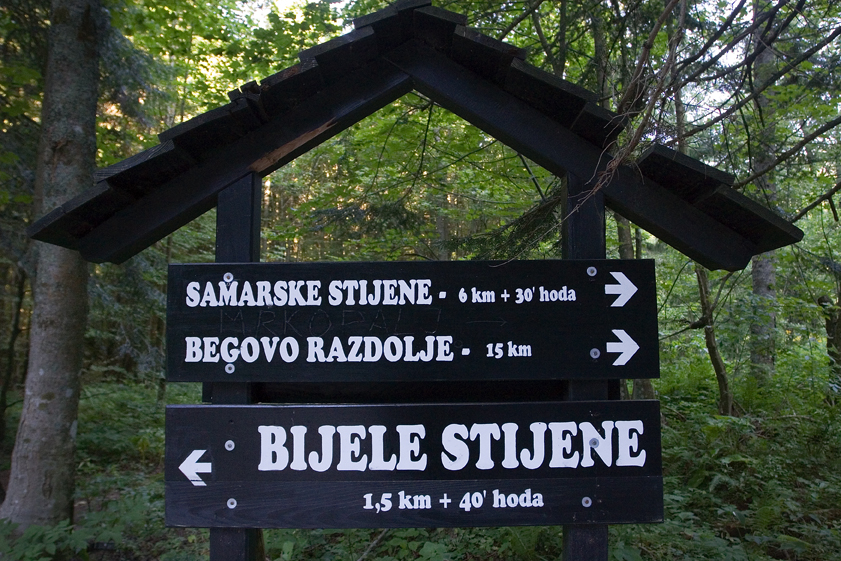
TIPS
You can reach Bijele stijene with your car through the mountain road from Jasenak village (pull of the asphalt road in direction to Jezerane – watch fot a sign, then continue on a dirt road until you see another sign). If your car is 4×4, you can climb even more, and park your car near the Smll shelter. From here, just climb for 45 minutes to the mountain hut or refuge on Bijele Stijene. Alternatively, you can hike from the asphalt road; it takes one more hour longer.
Goran Šafarek, biologist and author of several books and films about Croatia. Don’t forget to follow us on our Instagram, Twitter and Facebook


